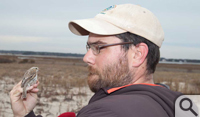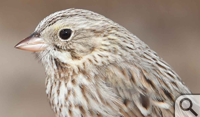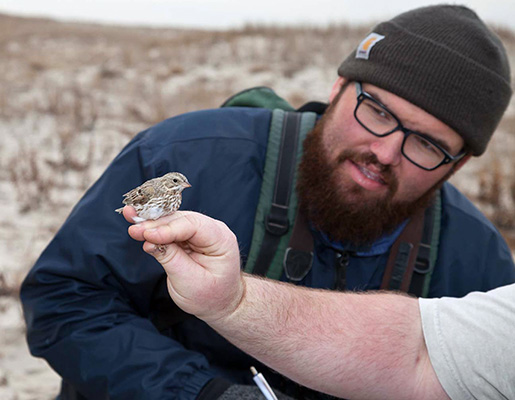A day of Ipswiching
Seeking out a rare sparrow, denizen of the dunes, on Metompkin Island
The subdued color palette of this habitat is reminiscent of west Texas.
The exposure to heat and the lack of water during the growing season have shaped the plant community in a way similar to Texas, but the smell of the Atlantic just over the dunes and the sight of willets and dunlin rising and falling over distant mudflats give a clue that we are nowhere near El Paso. We are on Metompkin Island in the dead of winter, walking south through a large patch of dune grassland.
Despite its proximity to the major resort towns of Virginia Beach and Ocean City, Metompkin is wild. Jointly owned by The Nature Conservancy and the U.S. Fish and Wildlife Service, the island has no engineering structures that impede nature’s movements. Here, water and sand are free to perform their give-and-take dance as they have always done. The result is a natural gem.
 Fletcher Smith and I have come here to check on one of the beneficiaries of this wild stretch of coastline, the Ipswich sparrow. With us are long-time members of a group of die-hard birders and friends of the Center for Conservation Biology that I’ve come to call the Royal Society of Bird Sages: Harry Armistead, Ned Brinkley and Bob Anderson. The Royal Society is accompanied by a couple of younger birders, Ellison Orcutt and Zak Poulton, all intent on seeking out the Ipswich sparrow.
Fletcher Smith and I have come here to check on one of the beneficiaries of this wild stretch of coastline, the Ipswich sparrow. With us are long-time members of a group of die-hard birders and friends of the Center for Conservation Biology that I’ve come to call the Royal Society of Bird Sages: Harry Armistead, Ned Brinkley and Bob Anderson. The Royal Society is accompanied by a couple of younger birders, Ellison Orcutt and Zak Poulton, all intent on seeking out the Ipswich sparrow.
A ‘salt life’ sparrow
The Ipswich is a true coastal sparrow, spending its entire life cycle in dune habitat along the Atlantic Coast. Its breeding range is restricted to Sable Island off the coast of Nova Scotia, Canada, where it nests in dune and heath habitat. Its primary winter habitat includes coastal barriers and beaches along the Atlantic Coast. The global population is estimated to be only 6,000 individuals. Although breeding habitat on Sable Island is secure, winter habitat for this specialized sparrow is threatened by sea-level rise, coastal development and our insatiable desire to walk along the beach.
 In a broad survey of distribution during the winter of 1971, Wayne Stobo and Ian McLaren determined that the Ipswich’s center of abundance during the winter season fell between Virginia and New Jersey. A 2012 survey conducted by the Center for Conservation Biology placed the Virginia bulls-eye right on the south end of Metompkin Island. During that winter, we recorded nearly 20 birds per kilometer of island here. The birds use areas with a diverse topography, where storms have disrupted the dune line and where bunches of grass and seaside goldenrod provide both seeds and hides. Their distinctive, dune-colored plumage is a direct match to the habitat. Watching the birds work through the sand, there is no question that they belong here.
In a broad survey of distribution during the winter of 1971, Wayne Stobo and Ian McLaren determined that the Ipswich’s center of abundance during the winter season fell between Virginia and New Jersey. A 2012 survey conducted by the Center for Conservation Biology placed the Virginia bulls-eye right on the south end of Metompkin Island. During that winter, we recorded nearly 20 birds per kilometer of island here. The birds use areas with a diverse topography, where storms have disrupted the dune line and where bunches of grass and seaside goldenrod provide both seeds and hides. Their distinctive, dune-colored plumage is a direct match to the habitat. Watching the birds work through the sand, there is no question that they belong here.
Will sea level rise bother the Ipswich?
We have come today to check on numbers and to do some banding in preparation for more focused efforts in future winters. We have not checked on the birds since the survey of 2012. Although a considerable body of literature has been published on the breeding grounds, very little is known about the winter ecology of this dune specialist. Several questions that are important to the future of this population remain unanswered. Which habitat attributes are critical during the winter? How may critical habitat components be impacted by sea-level rise and coastal change? How high is site fidelity?
We work only the northern two kilometers of habitat and turn back to reach the boats before they are stranded by low tide. We encountered 25 to 30 Ipswich sparrows within the short section of habitat and banded eight. We leave with a sense of confidence that this site will be an ideal venue for unraveling the winter ecology of this unusual form. ![]()
Bryan Watts is director of the Center for Conservation Biology, a joint program of William & Mary and Virginia Commonwealth University.















